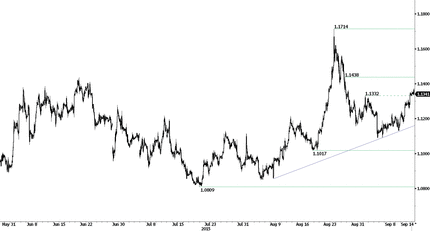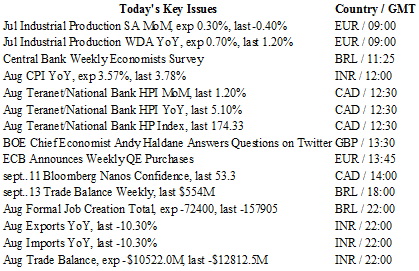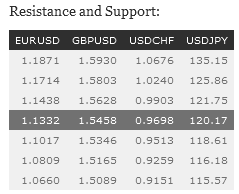Forex News and Events
Swiss inflation fell deeper into negative territory
In Switzerland, disinflationary pressures remained high in August according to the Federal Statistical Office as prices decreased further in August. The producer and import price index fell 6.8%y/y in August, versus -6.7% median forecast, following a decrease of 6.4% in July. More specifically, the pressure on chemical, pharmaceutical and petroleum product prices increased substantially over the period. However, we believe that the pressure on prices will stabilize in the coming months, as the effects of a weaker Swiss franc start to kick in.
July’s real retail sales surprised to the upside this morning, printing at -0.1%y/y from a revised figure of -1.2%y/y in June. Once you take into account the seasonal adjustment, retail sales contracted 0.6%y/y in July.
EUR/CHF is having a hard time breaking the strong 1.10 threshold. However, we think that the outflow from emerging markets will likely be beneficial for the EUR as traders stop using the euro as a funding currency. Moreover, the recent divergence in economic data between the two areas will incite traders to start looking for higher yielding investments in the euro zone.
Germany challenges the principle of open borders
The European Central Bank left its rate unchanged at 0.05% earlier this month. At the following conference, Mario Draghi has warned that the European Central Bank is likely to expand the asset program purchase beyond 2016. In addition it has been said the ECB is willing to step up stimulus and therefore to buy more bonds. It seems policymakers are concerned by the possible inefficiency of this monetary policy. Indeed, after years of quantitative easing, both the U.S. and Japan economy are still struggling toward the path of a sustainable recovery. Besides, both countries have an astonishing debt-to GDP ratio. We think that QE, couple with a zero-interest rate policy, only floods equity market with free money without creating any more value.
Following these declarations, the benchmark 10-year Bund yield is now trading at 0.659%, its lowest level in three weeks. We think that the Eurozone growth is at stake. By providing hints of a possible increase of its bond-buying program, the ECB is maintaining deflationary pressures. And this is not likely to stop any time soon. Last but not least, it is also worth adding that the integrity of the Eurozone is in danger as Germany reintroduced border controls with Austria in total contradiction to the principle of open borders, to which most EU member states, have committed.
Hence, we remain bearish on the EURUSD. The outlook is clearly negative for Europe. Nonetheless within the next few days, the pair will mainly be driven by the FOMC decision on September 17. The week promises to be extremely volatile.
Hike expected in September
Finally, the wait is nearly over. On Thursday, the FOMC will decide whether to raise its benchmark rate or maintain a zero interest rate policy. But unless you have been under a rock for the last six months you already know that. The data is relatively balanced, fueling a debate, which shows no sign of losing momentum this Monday morning. US 10-year treasury yields have been consolidating around the 2.18% level indicating the uncertainty in the market.
While our desk is split on the “timing” of the Fed’s launch, I believe that the Fed will raise rate by 25bp on September 17. The rational is based partially on the data and partially on logical deduction. The US economy expanded at an annualized pace of 3.7% in Q2 and there are roughly 200k new jobs being created per month. With the unemployment rate at 5.1%, it’s only a matter of time before companies start meaningfully increasing incentives (as suggested by the Taylor rule) and pushing up wage inflation (which is already trending mildly higher - 0.3% in Aug). But perhaps the stronger argument for a rate hike comes from the qualitative side. The Fed’s extending monetary policy strategy has clearly created bubbles in asset prices. A perfect illustration of this unintended consequence can be seen in the recent volatility in emerging markets. Normal risk-averse investors were starved for yields and forced to seek returns in artificially low, volatile sources. After nearly six years of ignoring common-sense valuations, investors have spent the last 12 months unwinding these risky positions. In effect, almost all emerging market currencies are down over 10% against with USD, while RUB, BRL and TRY are down over 30%. Utilizing powerful tools such as quantitative easing and zero (or negative) interest rate policy is like dancing with the devil, you need find a new partner before the music stops. With China’s economy on the brink of a potential “hard landing”, the music is definitely slowing. The recent sell-off has made investors prudently cautions but still risk-taking. Holding rates low for longer will only encourage uninhibited risk-seeking behavior.
The other argument for raising rates is that the likely result of a steepening yield curve is that consumers and businesses begin to spend, rather than save as traditional Keynesian theory suggests. In practice after an initial bounce, permanently low yields create a liquidity trap as real investments are delayed. The threat of higher yields should stimulate activity as investors realize that further delays will have additional costs. This line of thinking suggests that growth can actually benefit from a 25bp hike and gradually steepening rate outlook rather than stymie the acceleration. Heading into the FOMC meeting, I remain bullish on USD and negative on EM currencies.
Resistance At 1.1332 Has Been Broken 

The Risk Today
EUR/USD is moving higher. Hourly resistance is now given at 1.1438 (01/09/2015 high) and stronger resistance lies at 1.1714 (24/08/2015 high). Support can be found at 1.1017 (18/08/2015 low). In the longer term, the symmetrical triangle from 2010-2014 favored further weakness towards parity. As a result, we view the recent sideways moves as a pause in an underlying declining trend. Key supports can be found at 1.0504 (21/03/2003 low) and 1.0000 (psychological support). We have broken the resistance at 1.1534 (03/02/2015 reaction high). We are entering an upside momentum.
GBP/USD is now consolidating. Hourly resistance at 1.5443 (28/08/2015 high) has been broken. Hourly resistance at 1.5509 (27/08/2015 high) is at stake. However we think that the 61.8% Fibonacci retracement at 1.5087 is on target in the medium term. In the longer term, the technical structure looks like a recovery bottom whose maximum upside potential is given by the strong resistance at 1.6189 (Fibo 61% entrancement).
USD/JPY is moving in either direction. Hourly support is given at 118.61 (04/09/2015 low). Stronger support can be found at 116.18 (24/08/2015 low). Hourly resistance can be found at 121.75 (28/08/2015 high). A long-term bullish bias is favored as long as the strong support at 115.57 (16/12/2014 low) holds. A gradual rise towards the major resistance at 135.15 (01/02/2002 high) is favored. A key support can be found at 118.18 (16/02/2015 low).
USD/CHF has failed to hold above 0.9700 and is now pushing lower. Hourly support is given at 0.9513 (27/08/2015 low). Hourly resistance lies at 0.9903 (11/08/2015 high). On the very short-term term, the pair is setting higher highs. Therefore we remain bullish on the pair. In the long-term, the pair has broken resistance at 0.9448 suggesting the end of the downtrend. This reinstates the bullish trend. Key support can be found 0.8986 (30/01/2015 low).

